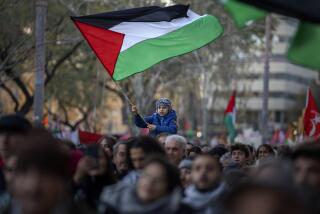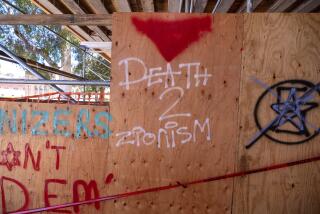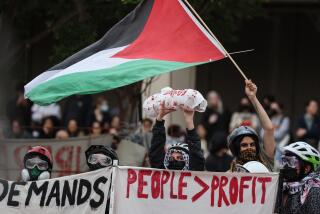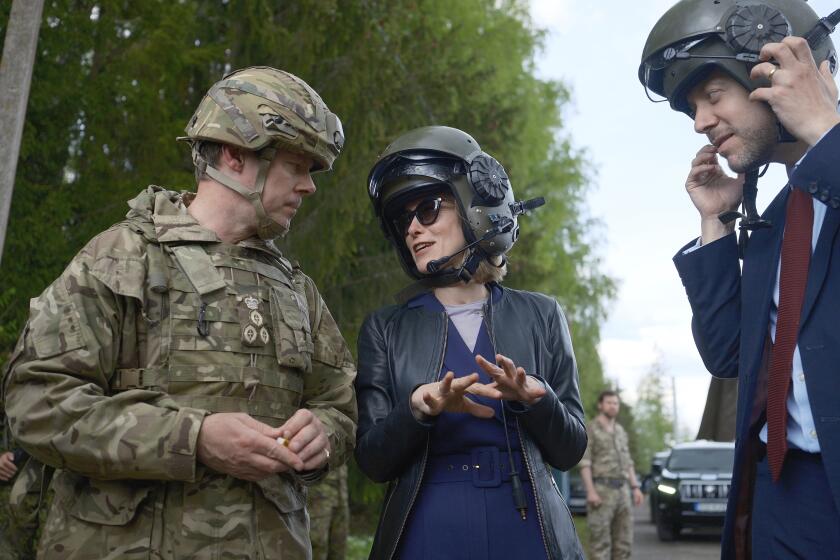Serb-Croat Dispute Over Krajina a Potential Powder Keg : Balkans: The Serbian-held region of Croatia holds a vote this weekend. It could lead to bloody warfare.
The crude black writing scrawled defiantly on the wall at the entrance to town left little room for speculation: “In Diablo We Trust.”
In many ways, God seems to have abandoned this lovely land of emerald hills, delicate villages, cattle munching hay at the roadsides and churches whose new gravestones are draped with roses wilting in the afternoon sun.
This is Croatia’s connection to the Dalmatian Coast, a vital link of railroads, highways and oil pipelines without which Zagreb is cut off from the southern half of its territories.
It also is, according to Kalashnikov-toting residents of Knin who have declared an independent nation on these Croatian territories, the Serbian Republic of Krajina, where a crucial vote that may escalate regional tensions is set for this weekend.
In Knin, one speaks the Serbian dialect or one is politely encouraged not to speak. The currency is Krajina dinars, but the hideously inflated Belgrade dinar is welcomed too. Cars with Croatian registration are abruptly turned back at checkpoints flying the Serbian emblem of twin eagles.
The dispute between Croats and Serbs has already led to an armed conflict. It eased 18 months ago with the stationing of U.N. peacekeeping troops throughout Krajina, bringing peace to Croatia and turning the world’s attention to the worsening conflict to the east and south in Bosnia-Herzegovina.
But recent months have shown that rural Krajina, a rugged frontier between East and West since time immemorial, is not only an unresolved issue; in the eyes of U.N. monitors, it is a potential conflict, shaping up even more dangerously than the one in neighboring Bosnia.
The new harder-line focus in the rump Yugoslavia, with the dismissal of President Dobrica Cosic last month, threw into motion events that have raised the prospect of a new Serb-Croat war that could be even larger than the last in its participants and territories.
In recent weeks, Croatia has massed five more brigades of troops along the Krajina borders, Serbian military commanders report. Sporadic shelling of villages on both sides has escalated into nightly confrontations. Krajina Serbs have responded by declaring 100% mobilization and a 10 p.m. curfew.
The Serbs, sensing the heat being turned up from Croatia but also feeling increasingly estranged from Belgrade, escalated tensions by announcing a referendum, scheduled for Saturday, to join Bosnian Serbs in forming a greater republic of “Western Serbia.”
“If the Serbs decide to go up to the end, the Serbs in Bosnia and the Serbs in Krajina, the war will spread again, and this time you won’t be able to stop it. It will spread to the south, it will spread to the west, and you will have elements of a third world war,” Vesna Skare-Ozbolt, Croatia’s spokeswoman for the presidency, warned in an interview.
The danger, say U.N. and Western observers, is that the conflict in Krajina is at the heart of the dispute over what once was Yugoslavia. “It’s potentially the most explosive area of all, much more dangerous than Bosnia-Herzegovina,” said one European envoy. “Because it’s Serbs against Croats, which is basically what this war is all about.”
Fueling the Krajina conflict has been a combination of factors; as is always the case in the Balkans, events on the world stage play out in microcosm with spilled blood in the villages and mountains of this feuding land.
Perhaps most important, analysts say, was the Serbs’ growing conviction, after the United States backed down from its threats of military action, that the international community would not move decisively to intervene and halt the war. That cleared the way for all the parties to gain what they could, while they could.
The 550,000 Serbs in Krajina, who from the beginning refused to live as a minority within Croatia when the Croatian homeland was carved out of the former Yugoslav federation and given international recognition, have launched talks with Croatian authorities about tentative issues like economic development, opening roads through Krajina, rebuilding power stations and exploiting water resources for agriculture.
These talks, which resumed this week in Geneva after an uneasy hiatus, have fueled international optimism that a peaceful resolution might be achieved. But at the same time, this weekend’s referendum on joining with the Bosnian Serbs is a clear provocation that Croatia may find difficult to ignore.
One of the real issues is a declining faith among Krajina Serbs that the moderates who advocated dialogue with Zagreb were getting anywhere.
Croatia’s large-scale attack on Jan. 22, in which its troops overran U.N. peacekeepers and seized three vital facilities near the Adriatic Sea port of Zadar from the partially disarmed Serbs, sending thousands of new Serbian refugees streaming into camps, left a new climate in Knin in which the hard-liners appear to have made substantial gains.
“We are waiting for the attack of Croatia. It’s not good to say it, but we must wait. We do not like war, but we must be sure for our people and our land. If the world wants a war, it may have one . . . and we must be sure that this war will be worse than before,” said Djordje Bijegovic, Krajina’s “prime minister.”
In the recreation club of the former Yugoslav national army in downtown Knin, the Krajina Serb military has lined the walls with maps depicting the location of Croatian forces and new maps of the proposed Western Serbia, which, if approved in the referendum, will have its capital in Bosnia’s Banja Luka.
The deputy commander, Col. Kosto Novakovic, a soft-spoken, bespectacled man with a master’s degree in international relations, stood in front of the map and said, “If you look at the map, it’s true, it’s not easy to defend it. But if a nation is fighting for biological survival, then there are not any obstacles.
“If it were a greater map, you could see the Serbian territories on the whole,” he said. “It’s a united territory, and to prove that with one fact, I would point out that you can travel from one village close to Zadar to Belgrade by passing through Serbian territories only.”
From the mouths of Serbs reportedly estranged from Belgrade, this argument sounds chillingly like talk of a “Greater Serbia.” It offers a vision to hard-line Serbs of a push for a Serbian nation throughout what they see as its natural homeland, swallowing much of Bosnia, Croatia and perhaps other republics in the process.
In the cafeteria of a former movie theater in Petrinja, where the Krajina Serbian national assembly declared the unification referendum, a scant 150 meters from the Croatian border, Rade Leskovac of the nationalist Serbian Radical Party emerged, fatigued from the deliberations, and shrugged.
“You from the West often say we Serbs are trying to make a Greater Serbia. I say, why not? Are we not a great people?” he asked.
Leskovac, an ally of Serbian ultranationalist leader Vojislav Seselj, is unabashed as to his vision for Western Serbia. Krajina Serbs are ready to negotiate about borders with Zagreb, he says, but Krajina alone may not be enough for the hundreds of thousands of Serbs who lived in the urban areas of Croatia and who are now largely displaced.
“I came from the little town of Osijek near Vukovar. I lived there with my family. I had a wife and three children. I had a job with a newspaper there, and I had two shops. I drove a Mercedes for 28 years. I had a good life. Today I’m living in a little village with 500 inhabitants. My wife never saw a cow, and every day she must milk it, and every day I must help her.
“I have a good suggestion for the Croats,” he said, grinning. “In the future, when they sit around the table, it will be at our peaceful summit; we must want from them two towns. The first is Osijek, and then maybe Dubrovnik or Zadar.”
These are words guaranteed to make the hair rise on the back of any Croatian neck.
Croats, for their part, insist that the entire Krajina region is within Croatia’s internationally recognized borders; Croatia complains that U.N. peacekeepers have done nothing to fulfill their original mandate of disarming Serbs and returning displaced Croats to their homes in Krajina.
Croats have a creeping fear that the United Nations will allow Krajina to slip into a limbo like Cyprus, an officially disputed territory for nearly two decades. That would be deadly for Zagreb, which must regain Krajina if there is to be any hope of economic regeneration for a financially devastated country.
Serbian control of Krajina leaves Zagreb without authority over at least 22% of its territory and effectively cut off from the entire south of Croatia. It also puts a roadblock up against any hope of revitalizing tourism on the Dalmatian Coast, which previously earned up to $2 billion a year.
With the U.N. peacekeepers’ mandate expiring at the end of this month, Croatia has made it clear that if the world body can’t disarm the Serbs, Croatia can.
“We clearly stress that Croatia cannot accept any solution which would maintain the present status quo or ‘freeze’ the present situation,” Croatian President Franjo Tudjman said recently.
Croatia has offered to allow proportional representation of Serbs in local governments and a relative degree of autonomy in the two cities where Serbs held a majority, Knin and Glina. It has proposed extending the U.N. mandate in Krajina for six more months, providing the United Nations fulfills its pledge to disarm the Serbs, control borders and return displaced Croats to their homes.
The Serbs also want the United Nations to remain, fearing that Croatia will try to overrun them the minute the peace force leaves.
More to Read
Start your day right
Sign up for Essential California for news, features and recommendations from the L.A. Times and beyond in your inbox six days a week.
You may occasionally receive promotional content from the Los Angeles Times.






